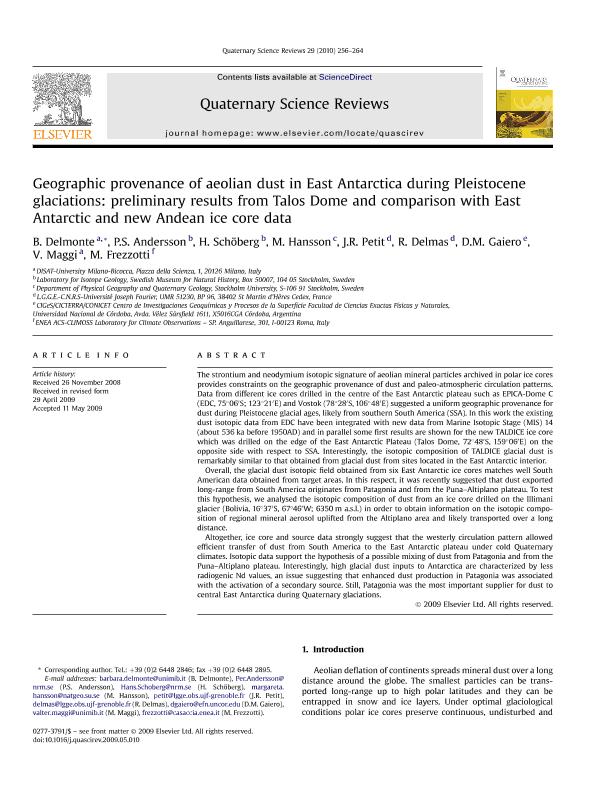Mostrar el registro sencillo del ítem
dc.contributor.author
Delmonte, B.
dc.contributor.author
Andersson, P. S.
dc.contributor.author
Schöberg, H.
dc.contributor.author
Hansson, M.
dc.contributor.author
Petit, J. R.
dc.contributor.author
Delmas, R.
dc.contributor.author
Gaiero, Diego Marcelo

dc.contributor.author
Maggi, V.
dc.contributor.author
Frezzotti, M.
dc.date.available
2018-08-08T13:16:07Z
dc.date.issued
2010-01
dc.identifier.citation
Delmonte, B.; Andersson, P. S.; Schöberg, H.; Hansson, M.; Petit, J. R.; et al.; Geographic provenance of aeolian dust in East Antarctica during Pleistocene glaciations: preliminary results from Talos Dome and comparison with East Antarctic and new Andean ice core data; Pergamon-Elsevier Science Ltd; Quaternary Science Reviews; 29; 1-2; 1-2010; 256-264
dc.identifier.issn
0277-3791
dc.identifier.uri
http://hdl.handle.net/11336/54533
dc.description.abstract
The strontium and neodymium isotopic signature of aeolian mineral particles archived in polar ice cores provides constraints on the geographic provenance of dust and paleo-atmospheric circulation patterns. Data from different ice cores drilled in the centre of the East Antarctic plateau such as EPICA-Dome C (EDC, 75°06′S; 123°21′E) and Vostok (78°28′S, 106°48′E) suggested a uniform geographic provenance for dust during Pleistocene glacial ages, likely from southern South America (SSA). In this work the existing dust isotopic data from EDC have been integrated with new data from Marine Isotopic Stage (MIS) 14 (about 536 ka before 1950AD) and in parallel some first results are shown for the new TALDICE ice core which was drilled on the edge of the East Antarctic Plateau (Talos Dome, 72°48′S, 159°06′E) on the opposite side with respect to SSA. Interestingly, the isotopic composition of TALDICE glacial dust is remarkably similar to that obtained from glacial dust from sites located in the East Antarctic interior. Overall, the glacial dust isotopic field obtained from six East Antarctic ice cores matches well South American data obtained from target areas. In this respect, it was recently suggested that dust exported long-range from South America originates from Patagonia and from the Puna-Altiplano plateau. To test this hypothesis, we analysed the isotopic composition of dust from an ice core drilled on the Illimani glacier (Bolivia, 16°37′S, 67°46′W; 6350 m a.s.l.) in order to obtain information on the isotopic composition of regional mineral aerosol uplifted from the Altiplano area and likely transported over a long distance. Altogether, ice core and source data strongly suggest that the westerly circulation pattern allowed efficient transfer of dust from South America to the East Antarctic plateau under cold Quaternary climates. Isotopic data support the hypothesis of a possible mixing of dust from Patagonia and from the Puna-Altiplano plateau. Interestingly, high glacial dust inputs to Antarctica are characterized by less radiogenic Nd values, an issue suggesting that enhanced dust production in Patagonia was associated with the activation of a secondary source. Still, Patagonia was the most important supplier for dust to central East Antarctica during Quaternary glaciations.
dc.format
application/pdf
dc.language.iso
eng
dc.publisher
Pergamon-Elsevier Science Ltd

dc.rights
info:eu-repo/semantics/openAccess
dc.rights.uri
https://creativecommons.org/licenses/by-nc-sa/2.5/ar/
dc.subject
East Antarctica
dc.subject
Talos Dome
dc.subject
Dust
dc.subject
Patagonia
dc.subject.classification
Meteorología y Ciencias Atmosféricas

dc.subject.classification
Ciencias de la Tierra y relacionadas con el Medio Ambiente

dc.subject.classification
CIENCIAS NATURALES Y EXACTAS

dc.title
Geographic provenance of aeolian dust in East Antarctica during Pleistocene glaciations: preliminary results from Talos Dome and comparison with East Antarctic and new Andean ice core data
dc.type
info:eu-repo/semantics/article
dc.type
info:ar-repo/semantics/artículo
dc.type
info:eu-repo/semantics/publishedVersion
dc.date.updated
2018-08-02T14:49:40Z
dc.journal.volume
29
dc.journal.number
1-2
dc.journal.pagination
256-264
dc.journal.pais
Países Bajos

dc.journal.ciudad
Amsterdam
dc.description.fil
Fil: Delmonte, B.. Università degli Studi di Milano; Italia
dc.description.fil
Fil: Andersson, P. S.. Swedish Museum for Natural History. Laboratory for Isotope Geology; Suecia
dc.description.fil
Fil: Schöberg, H.. Swedish Museum for Natural History. Laboratory for Isotope Geology; Suecia
dc.description.fil
Fil: Hansson, M.. Stockholms Universitet; Suecia
dc.description.fil
Fil: Petit, J. R.. Université Joseph Fourier; Francia
dc.description.fil
Fil: Delmas, R.. Université Joseph Fourier; Francia
dc.description.fil
Fil: Gaiero, Diego Marcelo. Consejo Nacional de Investigaciones Científicas y Técnicas. Centro Científico Tecnológico Conicet - Córdoba. Centro de Investigaciones en Ciencias de la Tierra. Universidad Nacional de Córdoba. Facultad de Ciencias Exactas Físicas y Naturales. Centro de Investigaciones en Ciencias de la Tierra; Argentina
dc.description.fil
Fil: Maggi, V.. Università degli Studi di Milano; Italia
dc.description.fil
Fil: Frezzotti, M.. Laboratory for Climate Observations; Italia
dc.journal.title
Quaternary Science Reviews

dc.relation.alternativeid
info:eu-repo/semantics/altIdentifier/url/https://www.sciencedirect.com/science/article/pii/S0277379109001693
dc.relation.alternativeid
info:eu-repo/semantics/altIdentifier/doi/https://doi.org/10.1016/j.quascirev.2009.05.010
Archivos asociados
